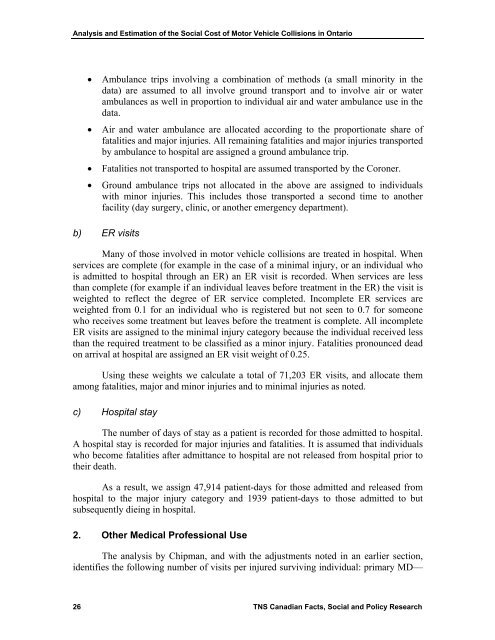Keith Vodden Dr. Douglas Smith - Transports Canada
Keith Vodden Dr. Douglas Smith - Transports Canada
Keith Vodden Dr. Douglas Smith - Transports Canada
You also want an ePaper? Increase the reach of your titles
YUMPU automatically turns print PDFs into web optimized ePapers that Google loves.
Analysis and Estimation of the Social Cost of Motor Vehicle Collisions in Ontario<br />
• Ambulance trips involving a combination of methods (a small minority in the<br />
data) are assumed to all involve ground transport and to involve air or water<br />
ambulances as well in proportion to individual air and water ambulance use in the<br />
data.<br />
• Air and water ambulance are allocated according to the proportionate share of<br />
fatalities and major injuries. All remaining fatalities and major injuries transported<br />
by ambulance to hospital are assigned a ground ambulance trip.<br />
• Fatalities not transported to hospital are assumed transported by the Coroner.<br />
• Ground ambulance trips not allocated in the above are assigned to individuals<br />
with minor injuries. This includes those transported a second time to another<br />
facility (day surgery, clinic, or another emergency department).<br />
b) ER visits<br />
Many of those involved in motor vehicle collisions are treated in hospital. When<br />
services are complete (for example in the case of a minimal injury, or an individual who<br />
is admitted to hospital through an ER) an ER visit is recorded. When services are less<br />
than complete (for example if an individual leaves before treatment in the ER) the visit is<br />
weighted to reflect the degree of ER service completed. Incomplete ER services are<br />
weighted from 0.1 for an individual who is registered but not seen to 0.7 for someone<br />
who receives some treatment but leaves before the treatment is complete. All incomplete<br />
ER visits are assigned to the minimal injury category because the individual received less<br />
than the required treatment to be classified as a minor injury. Fatalities pronounced dead<br />
on arrival at hospital are assigned an ER visit weight of 0.25.<br />
Using these weights we calculate a total of 71,203 ER visits, and allocate them<br />
among fatalities, major and minor injuries and to minimal injuries as noted.<br />
c) Hospital stay<br />
The number of days of stay as a patient is recorded for those admitted to hospital.<br />
A hospital stay is recorded for major injuries and fatalities. It is assumed that individuals<br />
who become fatalities after admittance to hospital are not released from hospital prior to<br />
their death.<br />
As a result, we assign 47,914 patient-days for those admitted and released from<br />
hospital to the major injury category and 1939 patient-days to those admitted to but<br />
subsequently dieing in hospital.<br />
2. Other Medical Professional Use<br />
The analysis by Chipman, and with the adjustments noted in an earlier section,<br />
identifies the following number of visits per injured surviving individual: primary MD—<br />
26 TNS Canadian Facts, Social and Policy Research
















